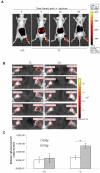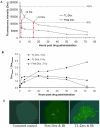Tumor-targeted delivery of liposome-encapsulated doxorubicin by use of a peptide that selectively binds to irradiated tumors
- PMID: 21075152
- PMCID: PMC3044774
- DOI: 10.1016/j.jconrel.2010.11.006
Tumor-targeted delivery of liposome-encapsulated doxorubicin by use of a peptide that selectively binds to irradiated tumors
Abstract
Tumor-targeted drug delivery improves anti-tumor efficacy and reduces systemic toxicity by limiting bioavailability of cytotoxic drugs to within tumors. Targeting reagents, such as peptides or antibodies recognizing molecular targets over-expressed within tumors, have been used to improve liposome-encapsulated drug accumulation within tumors and resulted in enhanced tumor growth control. In this report, we expand the scope of targeting reagents by showing that one peptide, HVGGSSV which was isolated from an in vivo screening of phage-displayed peptide library due to its selective binding within irradiated tumors, enabled highly selective tumor-targeted delivery of liposome-encapsulated doxorubicin and resulted in enhanced cytotoxicity within tumors. Targeting liposomes (TL) and non-targeting liposomes (nTL) were labeled with Alexa Fluor 750. Biodistribution of the liposomes within tumor-bearing mice was studied with near infrared (NIR) imaging. In the single dose pharmacokinetic study, the liposomal doxorubicin has an extended circulation half life as compared to the free doxorubicin. Targeting liposomes partitioned to the irradiated tumors and improved drug deposition and retention within tumors. The tumor-targeted delivery of doxorubicin improved tumor growth control as indicated with reduced tumor growth rate and tumor cell proliferation, enhanced tumor blood vessel destruction, and increased treatment-associated apoptosis and necrosis of tumor cells. Collectively, the results demonstrated the remarkable capability of the HVGGSSV peptide in radiation-guided drug delivery to tumors.
Copyright © 2010 Elsevier B.V. All rights reserved.
Figures





Similar articles
-
A novel peptide probe for imaging and targeted delivery of liposomal doxorubicin to lung tumor.Mol Pharm. 2011 Apr 4;8(2):430-8. doi: 10.1021/mp100266g. Epub 2011 Jan 27. Mol Pharm. 2011. PMID: 21222482
-
Combined targeting of perivascular and endothelial tumor cells enhances anti-tumor efficacy of liposomal chemotherapy in neuroblastoma.J Control Release. 2010 Jul 1;145(1):66-73. doi: 10.1016/j.jconrel.2010.03.015. Epub 2010 Mar 24. J Control Release. 2010. PMID: 20346382
-
Dose dependency of pharmacokinetics and therapeutic efficacy of pegylated liposomal doxorubicin (DOXIL) in murine models.J Drug Target. 2002 Nov;10(7):539-48. doi: 10.1080/1061186021000072447. J Drug Target. 2002. PMID: 12683721
-
[PEG-liposome in DDS and clinical studies].Nihon Rinsho. 1998 Mar;56(3):632-7. Nihon Rinsho. 1998. PMID: 9549348 Review. Japanese.
-
Pharmacokinetics and pharmacodynamics of lipidic nano-particles in cancer.Anticancer Agents Med Chem. 2006 Nov;6(6):513-23. doi: 10.2174/187152006778699121. Anticancer Agents Med Chem. 2006. PMID: 17100556 Review.
Cited by
-
High-Throughput Approaches to the Development of Molecular Imaging Agents.Mol Imaging Biol. 2017 Apr;19(2):163-182. doi: 10.1007/s11307-016-1016-z. Mol Imaging Biol. 2017. PMID: 27812924 Review.
-
Evaluation of Nanotargeted 111In-Cyclic RGDfK-Liposome in a Human Melanoma Xenotransplantation Model.Int J Mol Sci. 2021 Jan 22;22(3):1099. doi: 10.3390/ijms22031099. Int J Mol Sci. 2021. PMID: 33499267 Free PMC article.
-
Tumor-targeting peptides from combinatorial libraries.Adv Drug Deliv Rev. 2017 Feb;110-111:13-37. doi: 10.1016/j.addr.2016.05.009. Epub 2016 May 19. Adv Drug Deliv Rev. 2017. PMID: 27210583 Free PMC article. Review.
-
From phage display to nanoparticle delivery: functionalizing liposomes with multivalent peptides improves targeting to a cancer biomarker.Bioconjug Chem. 2013 Jan 16;24(1):85-96. doi: 10.1021/bc300498d. Epub 2013 Jan 7. Bioconjug Chem. 2013. PMID: 23186007 Free PMC article.
-
Recent Progress in the Theranostics Application of Nanomedicine in Lung Cancer.Cancers (Basel). 2019 Apr 29;11(5):597. doi: 10.3390/cancers11050597. Cancers (Basel). 2019. PMID: 31035440 Free PMC article. Review.
References
-
- Wagner TD, Yang GY. The Role of Chemotherapy and Radiation in the Treatment of Locally Advanced Non-Small Cell Lung Cancer (NSCLC) Current Drug Targets. 2010;11:67–73. - PubMed
-
- Pisters PW, Patel SR, Prieto VG, Thall PF, Lewis VO, Feig BW, Hunt KK, Yasko AW, Lin PP, Jacobson MG, Burgess MA, Pollock RE, Zagars GK, Benjamin RS, Ballo MT. Phase I trial of preoperative doxorubicin-based concurrent chemoradiation and surgical resection for localized extremity and body wall soft tissue sarcomas. J Clin Oncol. 2004;22:3375–3380. - PubMed
-
- Soper JT, Reisinger SA, Ashbury R, Jones E, Clarke-Pearson DL. Feasibility study of concurrent weekly cisplatin and whole abdominopelvic irradiation followed by doxorubicin/cisplatin chemotherapy for advanced stage endometrial carcinoma: a Gynecologic Oncology Group trial. Gynecologic oncology. 2004;95:95–100. - PubMed
-
- Madhankumar AB, Slagle-Webb B, Wang X, Yang QX, Antonetti DA, Miller PA, Sheehan JM, Connor JR. Efficacy of interleukin-13 receptor-targeted liposomal doxorubicin in the intracranial brain tumor model. Molecular cancer therapeutics. 2009;8:648–654. - PubMed
-
- Tuscano JM, Martin SM, Ma Y, Zamboni W, O’Donnell RT. Efficacy, biodistribution, and pharmacokinetics of CD22-targeted pegylated liposomal doxorubicin in a B-cell non-Hodgkin’s lymphoma xenograft mouse model. Clin Cancer Res. 2010;16:2760–2768. - PubMed
Publication types
MeSH terms
Substances
Grants and funding
LinkOut - more resources
Full Text Sources
Other Literature Sources
Medical
Miscellaneous

